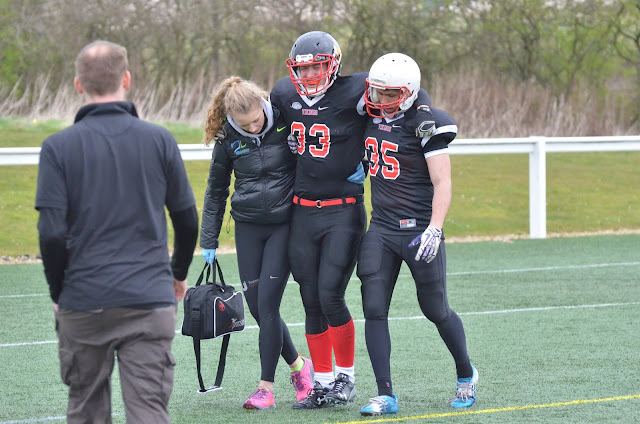A ‘complex pathophysiological process affecting
the brain, induced by biomechanical forces’ – Kuhn and Solomon, 2015
What?
Concussion, also known as minor traumatic brain
injury (TBI), is 'the sudden but short-lived loss of mental function that
occurs after a blow or other injury to the head' (NHS, 2014). Clinical signs
and symptoms encompass emotional, cognitive and physical areas.
Injury to the brain is caused by a sudden
acceleration or deceleration caused though a knock to the head.
This indirect force produces a violent jarring
of the brain within the skull. Unlike what we often think, the brain is not
fixed within the skull, it is suspended, the two do not move as one. Imagine an
apple within a Tupperware box. A violent knock to this box will cause the apple
to bash against the walls of the plastic box and become bruised. Such damage
occurs to the brain within the skull.
The brain balances a series of electrochemical
events in billions of brain cells. However when the brain is shaken or jarred
soft tissue damage occurs causing brain function to be temporarily disrupted.
This is when we might spot clinical changes within the individual.
Signs and symptoms
·
periods of memory loss/the
inability to recall
·
Disturbances in vision/seeing
double/seeing stars/blurred vision
·
A period of confusion
·
Headaches
·
Gait disturbance
·
Unsustainable sleeping patterns
·
Vomiting
·
Blank expression
·
Delay in answering
·
Drowsiness
·
Tonal changes
·
May or may not loose
consciousness (in fact only 10% of concussed individuals loose consciousness
These symptoms may
occur immediately following impact to the head, or can develop hours, days or
weeks later. If any of the symptoms becomes problematic or persistent, further
assessment should be made by a GP.
Between 1.6 and 3.6 million individuals are
affected by sports related concussions each year in the United States. Within
the 2011-2012 National Hockey League season 4,878 concussions were reported per
100 games. This sport has seen a steady rise greater than tenfold in the
concussion rate between the 1986-1987 season and 2011-2012 season.
Why is the incident rate increasing so
dramatically?
·
Increase in player size?
Athletes are now heavier, taller and stronger than previous years, meaning
there is more force travelling through each hit. Within the NHL player height
has increased by 1 inch and an average weight by 10 pounds.
·
Greater recognition and
reporting?
·
Player position - concussion is
also seen more commonly within some playing positions than others. For example,
within the National Football League, research has seen concussions to occur
more frequently in wide receivers, tight ends and defensive backs.
Mechanism of injury
Within sport, possible causes of concussion
include
·
head to head contact
·
Knee to head contact
·
Ball to head contact
·
Head to ground contact
·
Fighting - within the NHL, 9%
of concussions are due to fights between players.
·
Additionally, the NHL has
recognised concussion rates to be higher when the individual is unaware,
unexpecting and unprepared for a hit.
Management
Even a minor blow to the head may leave an
individual concussed. Someone who has a concussion may not necessarily be aware
of it, or they may not admit it due to a fear of being taken out of the game.
Symptoms of concussion can often be delayed, therefore it is important to
continuously assess the player. I suggest an on-pitch assessment, side-line
assessment and medical room assessment for constant watch of any deterioration
of health.
Immediate Pitch assessment should be actioned,
followed by a side-line and medical room assessment to watch for any
deterioration in symptoms.
IF IN DOUBT, SIT THEM OUT. Continuing to play
may increase the players risk of more severe, and/or longer lasting concussion
symptoms and an increase in a risk of other injuries. The SCAT3 form can used
to evaluate the level of injury.
Should the player show signs of a more serious
head injury, an immediate action of emergency care should be taken, i.e. CPR,
phoning 999 for an ambulance.
These symtoms include:
·
Remaining unconscious after the
initial injury
·
Lack of coordination or balance
·
Seizure or fit
·
Repeated vomiting or nausea
·
Slurred speech
·
Prolonged vision problems
·
Weakness in extremities
·
Fluid/blood leaking from the ears
or nose
·
A persistent headache
·
Sudden deafness
·
Difficulty staying awake
Return to play protocol
My own experience of dealing with concussion
over the past 4 years has changed. 4 years ago, it was difficult to get a
player to take a concussion injury seriously and they were often encouraged to
stay on the pitch despite my advice. However most recently, in light of new
research and guidelines, this is changing and if I tell a player they can’t go
back on, they don’t and my advice is fully supported by the coaches. I believe
there still needs to be better education across all sports with regards to
concussion but I have seen attitudes beginning to change. This can only be for
the better.
-E
Recommended Sites















